Key Points:
- Perennial grasses are plants that grow back every year after appearing to die out in the winter.
- These resilient plants are perfect for gardeners who don’t want to go through the hassle of planting new seeds each spring.
- Whether it be for strictly decorative purposes or for the sake of providing resources for local wildlife, perennial grasses are a welcome addition to any landscape.
Perennial ornamental grasses are an excellent way to add height, texture, and color to your garden or landscape. They often provide three seasons of beauty, plus many are drought-tolerant and low-maintenance. So for beautiful, durable ornamental grasses, check out our list of the 12 best perennial ornamental types of grass that come back every year. From spikey blue fescue to towering switch grass, there’s an ornamental grass on this list that will suit any garden style.
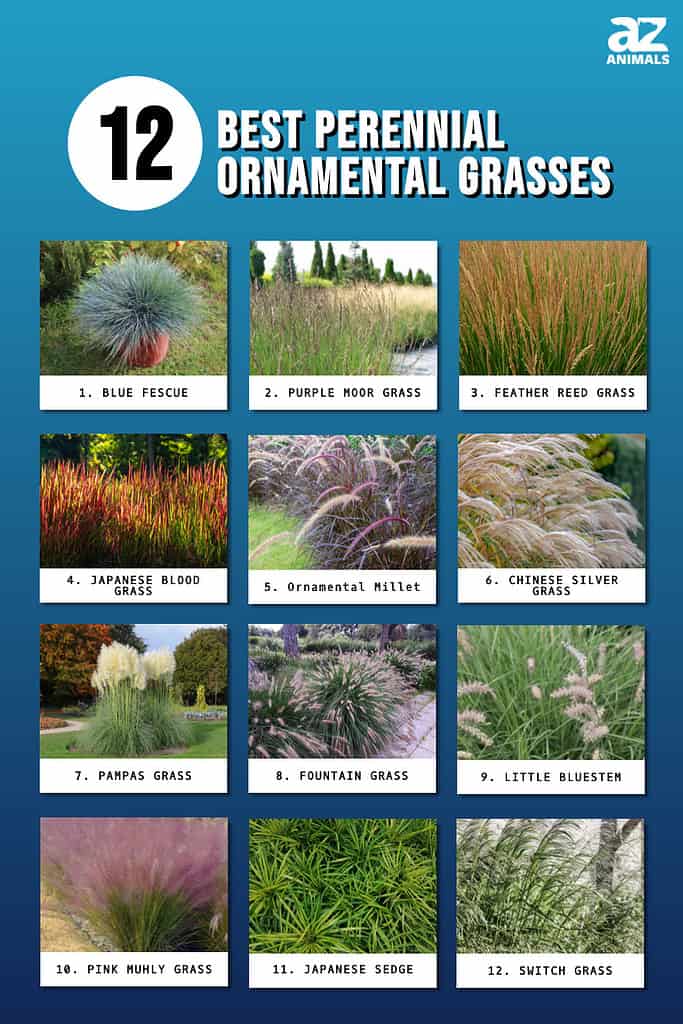
1. Blue Fescue (Festuca glauca)

Blue fescue is also quite drought-tolerant, making it a low-maintenance option for busy gardeners.
©Martina Unbehauen/Shutterstock.com
Like a spikey powder blue puffball, blue fescue is a perennial grass perfect for adding texture and interest to your garden. This ornamental grass has blue-green leaves that form a dense, mounded clump. Blue fescue grows best in full sun to partial shade and is tolerant of various soil types. And blue fescue is an excellent choice for rock gardens, borders, and mass plantings.
This grass is also quite drought-tolerant, making it a low-maintenance option for busy gardeners. Blue fescue will reach a height of 12-18 inches and has a spread of 12-24 inches. It is hardy in Zones 4-10.
Common cultivars of blue fescue ornamental grasses include ‘Beyond Blue’ and ‘Elijah Blue.’
2. Purple Moor Grass (Molinia caerulea)

Purple moor grass grows best in full sun to partial shade and moist, well-drained soil.
©AliScha/Shutterstock.com
Perfect for sunny garden beds, purple moor grass grows tall flowering spikes above its sloping mound of long leaves. The flat purple-tinged leaves turn deep, rich green in the summer. In addition, this slow-growing grass produces airy plumes of greenish-white flowers that turn from yellow to tan in the fall.
Purple moor grass grows best in full sun to partial shade and moist, well-drained soil. It is tolerant of many soil types and can even tolerate wet conditions. This grass will reach a height of 2-4 feet and spread of 1-2 feet. Purple moor grass is hardy in Zones 5-8.
3. Feather Reed Grass (Calamagrostis x acutiflora ‘Karl Foerster’)
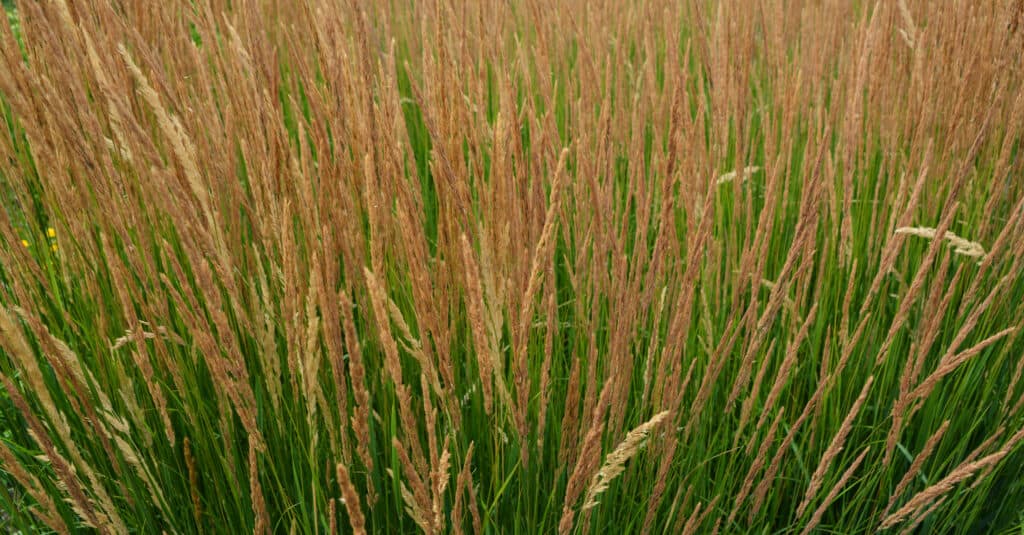
Feather reed grass grows best in full sun but tolerates some afternoon shade.
©meunierd/Shutterstock.com
Graceful feather reed grass cultivar ‘Karl Foerster’ looks like tall waves of wheat blowing in the breeze. This perennial ornamental grass has fine, feathery leaves that are green in the summer and turn a golden brown in the fall. In addition to its natural beauty, ‘Karl Foerster’ is an award-winning plant that won the Perennial Plant Association’s 2001 Perennial Plant of the Year.
Feather reed grass grows best in full sun but tolerates some afternoon shade. It grows nicely in various soil types — including heavy clay — and can even take wet conditions. This grass will reach a height of 3-6 feet and spread of 1-3 feet. Feather reed grass is hardy in Zones 5-9.
4. Japanese Blood Grass (Imperata cylindrica ‘Red Baron’)
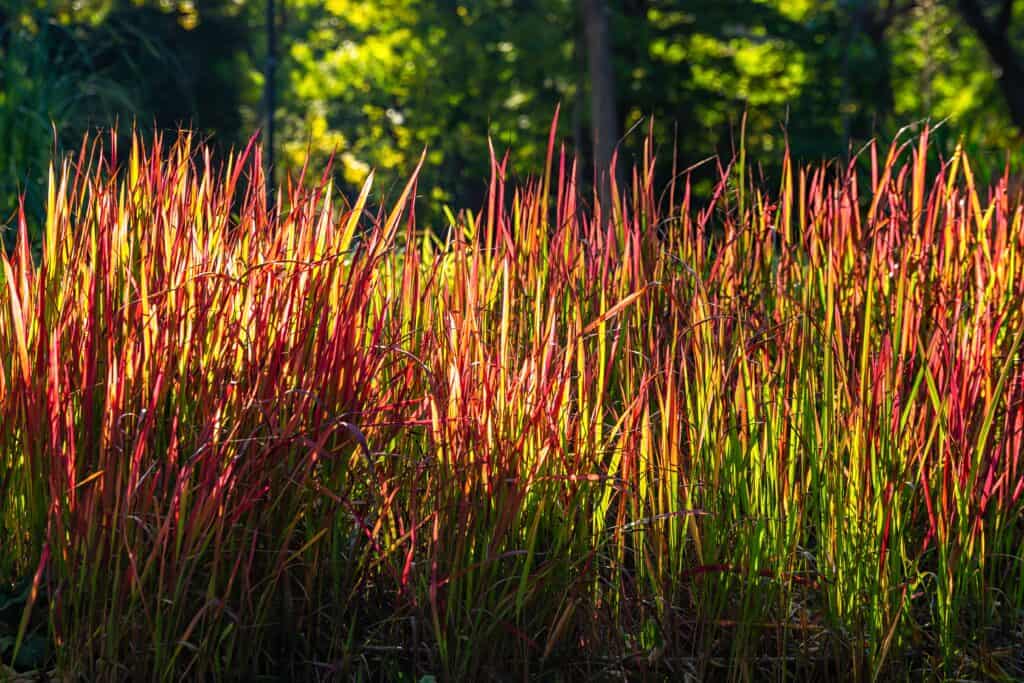
Popular Japanese blood grass cultivar ‘Red Baron’ is an excellent choice for container gardens.
©Maryia_K/Shutterstock.com
Crimson Japanese blood grass is a standout ornamental grass that adds bold color to your garden. This upright grass has bright green leaves in the spring. But in the summer, the top of this plant’s leaves turn crimson and deepen to burgundy in the fall. As a result, Japanese blood grass is a gardener favorite for multi-season interests.
Popular Japanese blood grass cultivar ‘Red Baron’ is an excellent choice for container gardens. In addition, ‘Red Baron’ perennial ornamental grass grows beautifully in rock gardens, borders, and as ground cover.
Japanese blood grass grows best in full sun or partially sunny garden beds. Though note that full sun is best for encouraging this grass’s deepest colors to appear. Japanese blood grass will reach a height of 2-3 feet and spread of 1-2 feet. It is hardy in Zones 5-9.
5. Ornamental Millet (Pennisetum glaucum ‘Purple Majesty’)
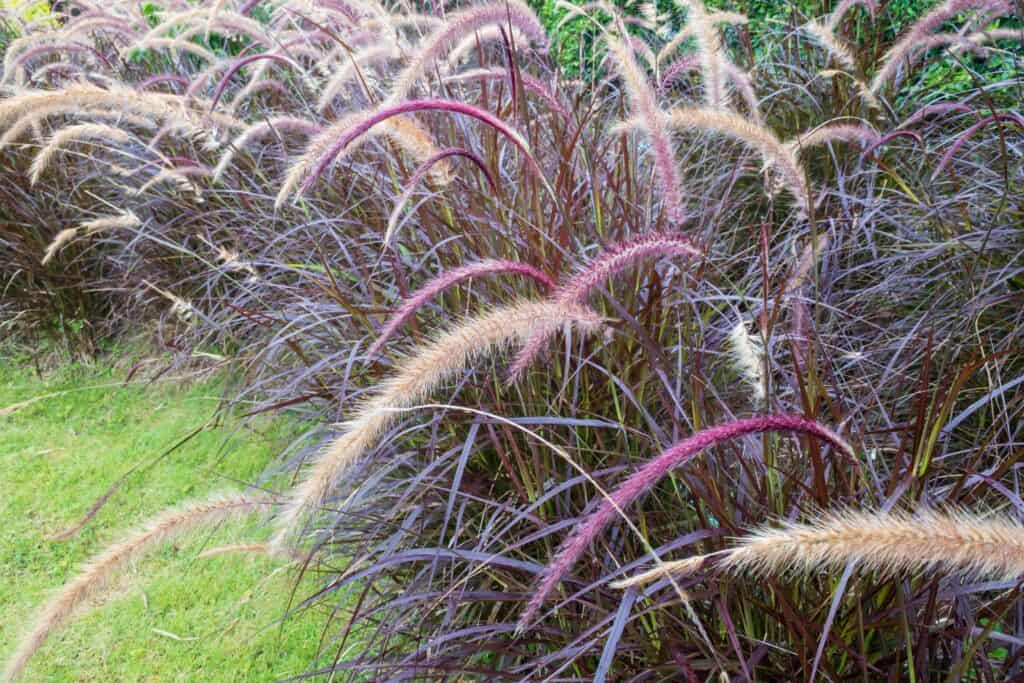
Ornamental millet ‘Purple Majesty’ grows best in full sun for the deepest color from spring through fall.
©socrates471/Shutterstock.com
Award-winning ornamental millet ‘Purple Majesty’ was developed by the University of Nebraska’s breeding program for millet grains. This dark brownish-purple plant has flat strap-shaped leaves and tall flower spikes that look like cattails. In addition to its deep purple color, ornamental millet attracts birds to your garden due to its tall spiked seed heads.
‘Purple Majesty’ was the 2003 All-American Selections Flower Winner. All-American Selections (AAS) is a North American non-profit organization that tests new plant varieties for best home garden performance.
Ornamental millet ‘Purple Majesty’ grows best in full sun for the deepest color from spring through fall. And despite its high cattail-like seed spikes, this plant doesn’t require stakes to hold it upright. You can expect this perennial to grow 3-6 feet tall and spread about 1-3 feet. Ornamental millet is hardy in Zones 2-11.
6. Chinese Silver Grass (Miscanthus sinensis ‘Kaskade’)

Chinese Silver Grass thrives in full sun and is drought-tolerant.
©Wut_Moppie/Shutterstock.com
Also called maiden grass, Chinese silver grass adds height and drama to your garden beds. It’s hard to choose just one cultivar of this dramatic perennial ornamental grass because many stunning varieties are available for home gardening.
We featured the Kaskade cultivar for its tall arching plumes cascading like a gentle, breezy waterfall. If that’s too poetic to visualize, think of 6-7 foot tall arching waves of grain. In addition, Chinese silver grass plants have pink tips that change to silvery-white as they mature.
The Royal Horticulture Society awarded this gorgeous ornamental grass their Award of Garden Merit in 2001.
Chinese Silver Grass thrives in full sun and is drought-tolerant. And, as with most ornamental grasses, it grows best in moist and well-drained soil. This perennial grass reaches a height of 6-8 feet and spreads 3-4 feet. Chinese Silver Grass is hardy in Zones 5-9.
7. Pampas Grass (Cortaderia selloana ‘Pumila’)
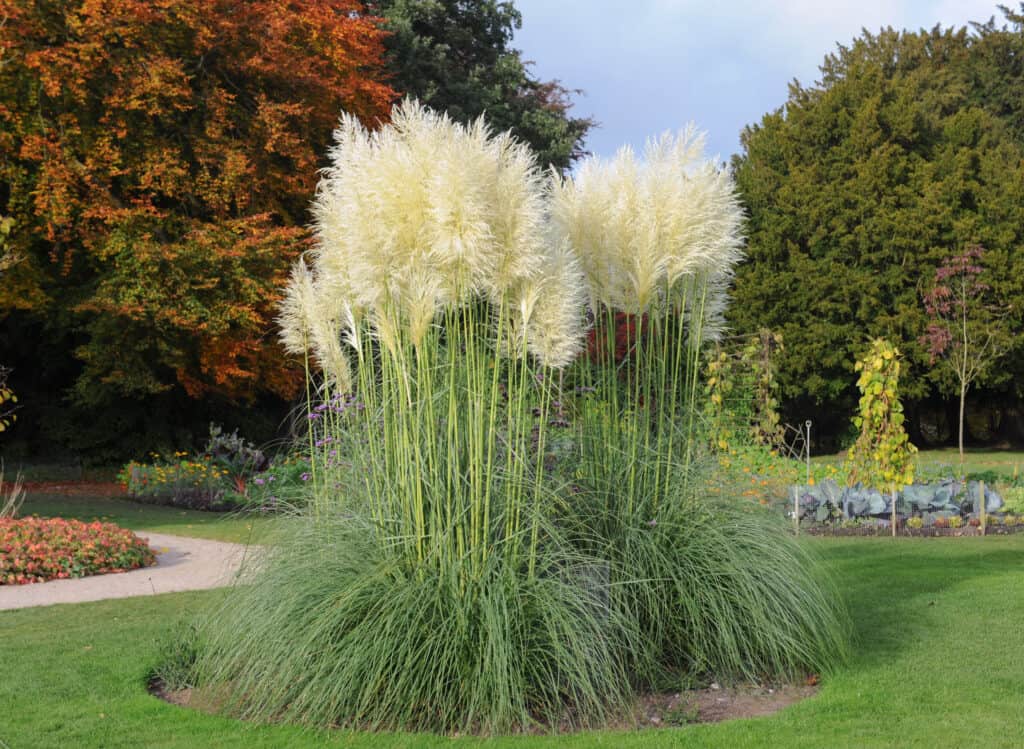
Pampas grass grows best in full sun or partial shade and can tolerate dry to medium (semi-moist) well-drained soil.
©Peter Turner Photography/Shutterstock.com
Known for its pale and fluffy plumes, pampas grass ‘Pumila’ is a medium-sized ornamental grass with unique features. First, the base of the plant is airy and elegantly bushy with long, thin green leaves. Then, soaring above its leafy base are the fluffy cream-colored plumes that make a showy statement. And a substantial additional benefit of growing this dramatic perennial grass is that it’s also showy through winter. Though note that the female plants tend to have the most dramatic plumes.
Plus, pampas grass ‘Pumila’ is another award winner on our list! This ornamental grass also earned the Royal Horticulture Society’s Award of Garden Merit.
Pampas grass grows best in full sun or partial shade and can tolerate dry to medium (semi-moist) well-drained soil. As a result, it is drought-tolerant. This grass will reach a height of 4-6 feet and spread 3-5 feet. Pampas grass ‘Pumila’ is hardy in Zones 6-10.
Important Note: Though pampas grass is very popular for gardens, crafts, and wedding bouquets, it is a strong self-seeder and may become invasive. For this reason, it is illegal to grow pampas grass in Australia and New Zealand. And this ornamental grass is classified as invasive in Hawaii, California, and other states along the West Coast of the US.
8. Fountain Grass (Pennisetum alopecuroides)
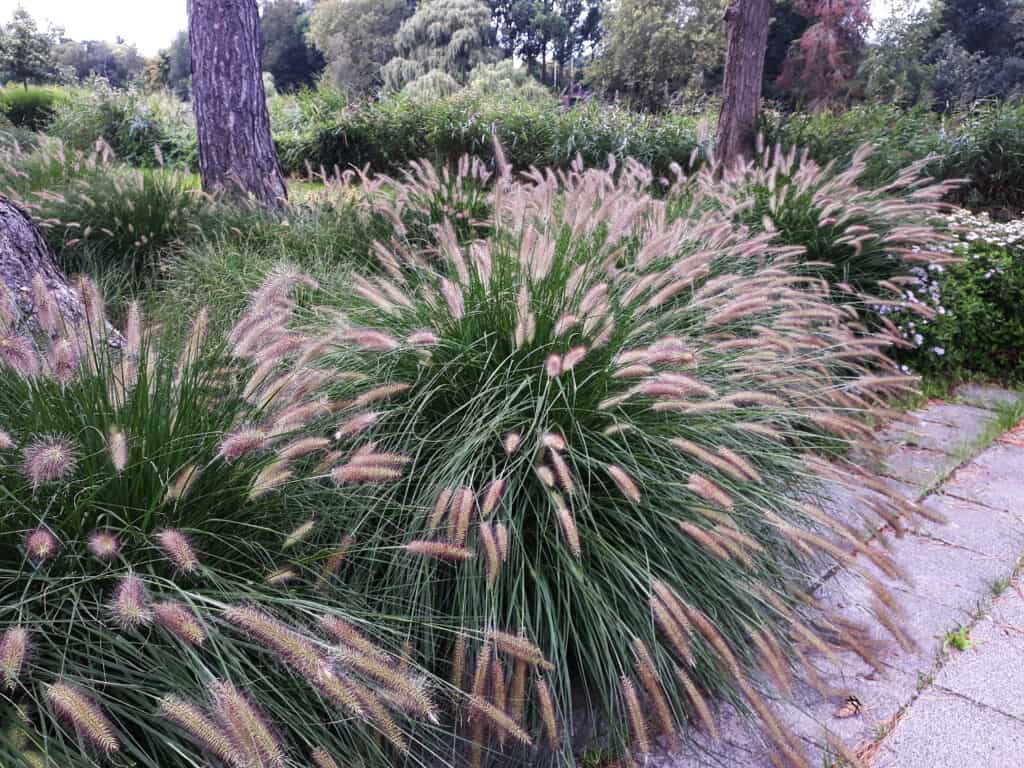
Many ornamental grasses have flower tips shaped like bottle brushes, and fountain grass is no exception.
©Gabriela Beres/Shutterstock.com
Another graceful perennial ornamental grass is fountain grass. It comes in many varieties, some with reddish stalks or tips. Basic fountain grass has arching green leaves topped with fluffy cream-colored flower heads that turn reddish later in the season.
Many ornamental grasses have flower tips shaped like bottle brushes, and fountain grass is no exception. But that’s part of the charm of these plants that add tall and billowing interest to the garden. And don’t forget to these decorative leaves to your flower arrangements! This perennial grass looks lovely in both fresh and dried floral displays.
Fountain grass grows best in full sun for optimal height and color. And fountain grass looks beautiful in winter, too. You can expect it to grow about 2-4 feet tall and spread 1-3 feet. Fountain grass is hardy in Zones 6-9.
9. Little Bluestem (Schizachyrium scoparium)
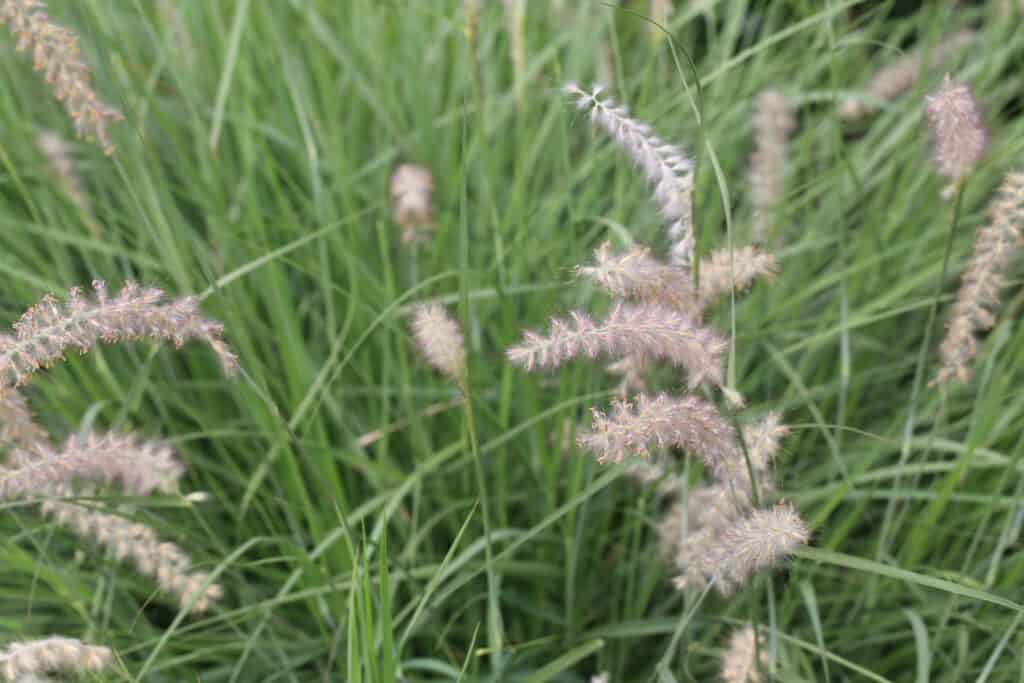
Little bluestem gets even more attractive when its tiny cottony seed heads appear.
©Traveller70/Shutterstock.com
Lovely little bluestem grass starts the season with blue-green leaves that later turn reddish-gold. Plus, if you don’t cut it back for the winter, its tall thin, reed-like leaves turn to a darker reddish-orange. So though it’s called little bluestem grass, this plant is known for its changing copper hues.
Little bluestem gets even more attractive when its tiny cottony seed heads appear. And those seed heads are a favorite snack for birds like cardinals, finches, and sparrows.
Grow little bluestem in full sun with well-drained soil from spring through winter. This perennial ornamental grass is drought-tolerant and doesn’t need cutting back until late winter or early spring. This perennial grass grows 2-4 feet tall and spreads about 1-2 feet. Little bluestem is hardy in Zones 3-9.
10. Pink Muhly Grass (Muhlenbergia capillaries)
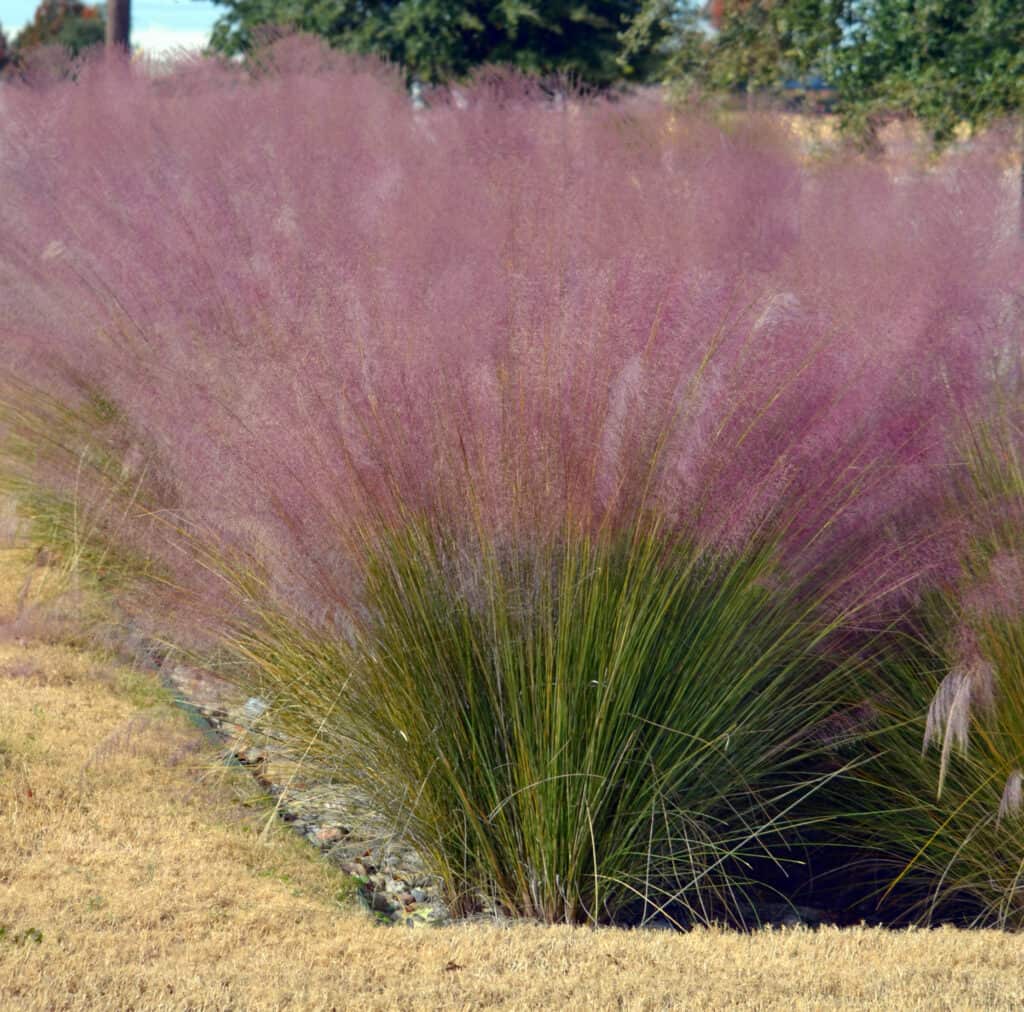
Though the leaf tops stay pink for many weeks, note that pink muhly grass eventually becomes tan.
©MaryAnne Campbell/Shutterstock.com
If you’d love to grow ornamental grass that looks like fluffy clumps of pink cotton candy, then pink muhly grass is right for you! This thin grass has deep pink leaves that are green in the center.
Though the leaf tops stay pink for many weeks, note that pink muhly grass eventually becomes tan. And this plant’s cottony tops take up the top half of the plant. So the pink fluff at the top looks like a ball of cotton candy on a stick, especially when seen from afar.
Pink muhly grass performs the best in sunny garden beds in well-drained soil. Also, note that this grass performs better in dry climates than in overly humid ones. And it will usually grow 2-3 feet tall and spread 1-2 feet wide. Pink muhly grass is hardy in Zones 6-11.
11. Japanese Sedge (Carex morrowii ‘Ice Dance’)

Japanese sedge
is native to low alpine areas in Japan and is grown for its attractive shape and foliage.
©Zaid Harith/Shutterstock.com
Try Japanese sedge if you want thick blades of green perennial ornamental grass in your garden. ‘Ice Dance’ cultivar creates dense rounded mounds of green foliage with cream or white borders. You can grow them as individual clumps or plant them en masse for a blanket of green and white garden interest.
Japanese sedge ‘Ice Dance’ is pretty versatile when it comes to its sun needs. It grows well in full sun, partial shade, and sometimes in fully shady areas. It does well in beds or containers with well-drained soil and grows spring through winter. This perennial grass gets as high as 1-2 feet and will spread an average of 2-3 feet. Japanese Sedge ‘Ice Dance’ is hardy in Zones 5-9.
12. Switch Grass (Panicum virgatum ‘Northwind’)

This variety of switch grass grows very tall (up to 6 or 7 feet) in 2-3 foot wide bunches that will knock your socks off.
©zelig8787/Shutterstock.com
Another ornamental grass with slightly thicker leaves than reed-style grass is the switch grass cultivar ‘Northwind.’ This variety of switch grass grows very tall (up to 6 or 7 feet) in 2-3 foot wide bunches that will knock your socks off. OK, not literally, but know that tall, billowing clumps of ‘Northwind’ switch grass make for grand and noticeable groupings in big garden beds.
This ornamental grass’s blue-green leaves in spring turn to golden yellow in the fall. In addition, this plant’s upright stems stay sturdy through the winter snow.
And, no surprise, this ornamental grass also earned the Royal Horticultural Society’s Award of Garden Merit.
Switchgrass ‘Northwind’ grows best in full to partial sun. It’s drought-tolerant and grows well in wet soil, too. This perennial grass reaches a height of 6-7 feet and spreads 2-3 feet. Switchgrass is hardy in Zones 5-9.
Animals Attracted to Ornamental Grasses
Another often overlooked benefit to planting perennial ornamental grass is that they offer vital resources to a host of local wildlife that will be readily available year after year. Small birds such as finches and sparrows may be seen gathering dried grasses in the autumn for nest-building or foraging for seeds during the warmer seasons.
Butterflies are another type of animal that love ornamental grasses. Caterpillars will feed upon the leaves until they are ready to build their chrysalis among the same nurturing flora. Once butterflies discover your perennial oasis they’ll be sure to make it an important rest stop during their migration.

If you plant perennial grasses you can turn your garden into a
butterfly
oasis.
©iStock.com/chris2766
Perennial Ornamental Grasses Add Beautiful Accents to Any Garden
Ornamental grasses come in many different sizes, colors, and varieties! And they’re perfect for adding low-maintenance height and flowy accents to any garden. Whether planted in large groupings or individual clumps, their leaves and plumes stay solid and attractive through fall and often winter.
We hope this list helps excite you to experiment with growing perennial ornamental grasses in your garden! If you could only choose one perennial ornamental grass for your garden, which would it be?
Summary of the 12 Best Perennial Ornamental Grasses
Here is a list of the 12 best perennial ornamental grasses that we took a look at.
| Rank | Grass | Height | Spread | Suitable Zones |
|---|---|---|---|---|
| 1 | Blue Fescue | 12-18 in | 12-24 in | 4-10 |
| 2 | Purple Moor Grass | 2-4 ft | 1-2 ft | 5-8 |
| 3 | Feather Reed Grass | 3-6 ft | 1-3 ft | 5-9 |
| 4 | Japanese Blood Grass | 2-3 ft | 1-2 ft | 5-9 |
| 5 | Ornamental Millet | 3-6 ft | 1-3 ft | 2-11 |
| 6 | Chinese Silver Grass | 6-8 ft | 3-4 ft | 5-9 |
| 7 | Pampas Grass | 4-6 ft | 3-5 ft | 6-10 |
| 8 | Fountain Grass | 2-4 ft | 1-3 ft | 6-9 |
| 9 | Little Bluestem | 2-4 ft | 1-2 ft | 3-9 |
| 10 | Pink Muhly Grass | 2-3 ft | 1-2 ft | 6-11 |
| 11 | Japanese Sedge | 1-2 ft | 2-3 ft | 5-9 |
| 12 | Switch Grass | 6-7 ft | 2-3 ft | 5-9 |
The photo featured at the top of this post is © Peter Turner Photography/Shutterstock.com
Sources
- MONROVIA NURSERY COMPANY, Available here: https://www.monrovia.com/ice-dance-japanese-sedge.html
- Gardenia.net, Available here: https://www.gardenia.net/plant/imperata-cylindrica-red-baron-japanese-blood-grass
- Missouri Botanical Garden, Available here: https://www.missouribotanicalgarden.org/PlantFinder/PlantFinderDetails.aspx?taxonid=285206
Thank you for reading! Have some feedback for us? Contact the AZ Animals editorial team.






